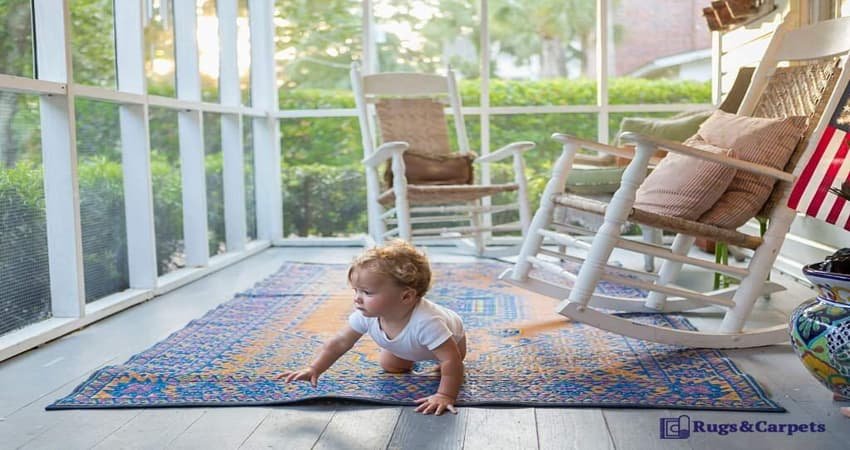One of the most common question we get asked is whether outdoor rugs can be left outside when it rains. The simple answer is yes, outdoor rugs are designed to withstand rain and can be exposed to it without any issue.
Outdoor rugs are specifically designed to withstand outdoor conditions, making them an excellent addition to your patio, deck, or any outdoor space. These rugs are crafted using durable materials that are resistant to water, mold, mildew, and fading. They are built to handle the challenges , including rain showers and sun exposure.
Here we will get outdoor rugs and explore their ability to withstand wet conditions. So, let’s dive in and find out if your outdoor rug can handle a downpour or two.
What Are the Best Type of Outdoor Rugs?

- You should choose a rug composed of synthetic materials.
- Wool and cotton are natural fabrics that absorb moisture and are susceptible to deterioration when exposed to the environment.
- Synthetic materials, such as polypropylene or polyester, are far more resistant to water and will not deteriorate when exposed to the environment.
- The quantity of foot activity on outdoor rugs and their maximum usage.
- If you put your rug in a high-traffic location, such as a porch or patio, you will want to choose a robust rug that can handle heavy usage.
- Synthetic outdoor rugs are often more durable than those created from natural fibers and may better withstand heavy foot activity.
Ensuring your rug can withstand various weather conditions is crucial, and that’s why it’s essential to select a rug that is resistant to mold, stains, and mildew while being easy to clean. The great news is that Rugs and Carpets Store offers a range of outdoor rugs that meet all these requirements.

The Resilience of Outdoor Rugs
Outdoor rugs are design to handle moisture, including rainwater. Unlike indoor rugs that may get damaged or develop mold when exposed to water, outdoor rugs are designed to repel moisture and dry quickly. This resilience is due to the inherent properties of the materials used in their construction.
Water-Resistant Materials
Polypropylene and polyester, the primary materials used in outdoor rugs, are hydrophobic in nature. This means they naturally repel water and prevent it from seeping into the rug’s fibers.

When rainwater hits an outdoor rug, it forms droplets on the surface, allowing you to easily shake off or blot away the water. The rug’s water-resistant properties also help prevent mold and mildew growth, ensuring a clean and healthy outdoor environment.
Quick-Drying Capabilities
The synthetic fibers used in their construction have a low absorbency rate, meaning they don’t soak up water like a sponge. Instead, the moisture evaporates rapidly, allowing the rug to dry out quickly after exposure to rain or humidity.

This attribute not only helps maintain the rug’s integrity but also minimizes the risk of odor or mildew formation.
Longevity and Durability
Outdoor rugs, built to withstand the elements, are crafted with longevity and durability in mind. They are deigned to endure rain, sun, and foot traffic without compromising their visual appeal.
Unlike traditional rugs that may fade or deteriorate when exposed to sunlight and water, outdoor rugs maintain their vibrant colors and structural integrity over time. This resilience ensures that your investment in an outdoor rug will last for seasons to come.
Tips for Maximizing the Lifespan of Outdoor Rugs
While outdoor rugs are designed to be durable, a little care and maintenance can go a long way in extending their lifespan. Here are some helpful tips to ensure your outdoor rug stays in top shape:
Regular Cleaning: Sweep or vacuum your outdoor rug regularly to remove dirt, debris, and loose fibers. This prevents the accumulation of grime and helps maintain its appearance.
Spot Cleaning: If your rug encounters a spill or stain, address it promptly by spot cleaning. Use a mild detergent mixed with water and gently blot the affected area with a clean cloth or sponge.
Proper Storage: During winter or extended periods of non-use, it is advisable to roll up and store your outdoor rug in a dry and protected area. This shields it from harsh weather conditions and extends its lifespan.
Read more: How To Paint Over Carpet?
FAQs
Do Outdoor Rugs Grow Mold?
Outdoor rugs are designed to be resistant to mold and mildew growth. The materials used in their construction, such as polypropylene or polyester, are inherently resistant to moisture and discourage mold growth.
However, if the rug is consistently exposed to excessive moisture and does not have the opportunity to dry properly, there is a possibility of mold development.
Will outdoor rugs lose their color if they get wet?
Outdoor rugs are typically made with fade-resistant materials that can withstand exposure to sunlight and moisture. While they may experience some color fading over time, it is generally minimal, and they will maintain their vibrancy for an extended period, even when getting wet.
Can outdoor rugs be used in humid climates?
Yes, outdoor rugs can be used in humid climates. Their water-resistant properties make them suitable for regions with high humidity. However, it’s important to ensure proper airflow and periodic cleaning to prevent moisture buildup and potential mold growth.
Conclusion
Outdoor rugs are a great way to decorate and protect your outdoor living area from dampness, dirt, and other factors. With proper care and upkeep, outdoor carpets may last for many years in pristine condition.
We hope this advice has given you a better idea of how to maintain the appearance of your outdoor rug and which materials perform best when exposed to rainy weather conditions. Add color, texture, and comfort to your garden with our fashionable and long-lasting outdoor rug!






